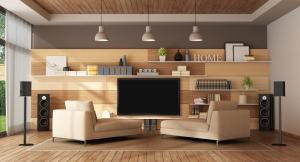Understanding the Differences Between Media Rooms and Home Theaters, Says Louisiana Audio Expert
Don Tucker, owner of D&D Audio and Video Solutions in Slidell, Louisiana, has seen a growing demand for both configurations, each offering distinct advantages depending on the goals of the project.
“Media rooms are designed for flexibility and multi-purpose use, while home theaters are built around immersive sound and acoustics in a controlled environment,” said Tucker.
A media room is typically an open or semi-open space that shares functionality with other activities. It may be located in a living room, bonus room, or family den. Seating is often casual and varied—ranging from sectionals to lounge chairs—and the space may include windows or high ceilings that contribute to ambient light and sound challenges. The layout supports group interaction, social gatherings, gaming, and television viewing.
In contrast, a home theater is a purpose-built room focused entirely on the entertainment experience. It is usually enclosed, acoustically treated, and isolated from external distractions. The seating layout is structured in rows, often with reclining theater chairs or tiered platforms for optimal sound direction and comfort. The lighting is controlled through dimmers, blackout shades, or wall sconces to enhance focus and minimize reflection.
The difference in design directly impacts equipment selection and audio performance. In a home theater, sound is engineered to deliver immersive experiences. Speaker placement, subwoofer calibration, and room acoustics are measured and tuned for consistent, balanced audio across all seating positions. These rooms often include architectural modifications to eliminate echo, manage low-frequency sound, and block noise from adjoining rooms.
Media rooms, on the other hand, must accommodate a wider range of use cases. Sound systems in media rooms tend to prioritize clarity and coverage over total immersion. The layout may need to support conversations, background audio, or light music in addition to entertainment. Because media rooms are often integrated into larger living spaces, sound may spill into adjacent areas or compete with other home activities.
Installation also varies between the two formats. Home theaters require more infrastructure—dedicated wiring, soundproofing materials, and structural customization. Media rooms often use existing room features and adapt to the layout already in place. This difference affects the construction timeline and planning process.
Lighting control is another differentiator. A home theater includes task-specific lighting with dimming zones and low-reflective surfaces to prevent distractions. Media rooms may rely on overhead fixtures, windows, or mixed-use lighting plans that support both daytime and nighttime activities. While lighting can be customized in either setting, its purpose in each case is distinct.
Control systems for both environments may include centralized remotes, wall panels, or app-based automation. In home theaters, controls are often fine-tuned to manage specific audio settings and room behavior. Media room controls are generally broader in scope and may integrate with smart home systems, adjusting settings for different users or activities.
Furniture layout also signals the intended purpose of the room. In a home theater, every seat faces forward, aligned for direct sound projection and central focus. In a media room, seating arrangements can be circular, L-shaped, or modular—allowing guests to face each other or the entertainment source, depending on the moment.
Room construction and acoustic treatment in a home theater are more intensive. Builders may install sound insulation within walls, acoustic panels, ceiling treatments, and door seals to minimize outside interference. Media rooms usually involve more compromise, adapting to an existing space without extensive modifications. As a result, audio performance is optimized to the degree possible within those limitations.
Budget planning is another consideration. Home theaters involve a detailed design process, including system engineering, architectural adjustments, and calibration. Media rooms tend to be more budget-flexible, with the option to scale up or down based on priorities such as sound, furniture, or integrated features.
Both options offer benefits, and the choice often comes down to lifestyle and intended use. Homeowners seeking a dedicated entertainment escape with isolated audio, mood lighting, and optimized layout may lean toward a home theater. Those looking for a more casual, multi-purpose environment that supports family activities and entertainment equally may opt for a media room.
Understanding these differences before starting a project allows for clearer expectations, better equipment selection, and a more satisfying end result. Each space serves a purpose, and with the right planning, either can deliver a high-performance entertainment environment.
Morgan Thomas
Rhino Digital, LLC
+1 504-875-5036
email us here
Visit us on social media:
Facebook
Legal Disclaimer:
EIN Presswire provides this news content "as is" without warranty of any kind. We do not accept any responsibility or liability for the accuracy, content, images, videos, licenses, completeness, legality, or reliability of the information contained in this article. If you have any complaints or copyright issues related to this article, kindly contact the author above.
Bio-Pharmaceutical Logistics Market 2025-2029: Unveiling Growth Developments with the Latest Updates
Demand for Chocolate Syrup Market is forecasted to reach a value of US $9.05 billion by 2029
Vending Machine Market Expected to Surpass $37.2 Billion by 2032 | North America Lead
Więcej ważnych informacji
 Jedynka Newserii
Jedynka Newserii

 Jedynka Newserii
Jedynka Newserii

Konsument

Polacy nie korzystają z hossy trwającej na warszawskiej giełdzie. Na wzrostach zarabiają głównie inwestorzy zagraniczni
Od października 2022 roku na rynkach akcji trwa hossa, nie omija ona także warszawskiej giełdy. Mimo to inwestorzy indywidualni odpowiadają zaledwie za kilkanaście procent inwestycji, a o wzrostach decyduje i na nich zarabia głównie kapitał z zagranicy. Widać to również po napływach i odpływach do i z funduszy inwestycyjnych. Zdaniem Tomasza Koraba, prezesa EQUES Investment TFI, do przekonania Polaków do inwestowania na rodzimej giełdzie potrzeba zysków z akcji, informacji o tych zyskach docierającej do konsumentów oraz czasu.
Polityka
Obowiązek zapełniania magazynów gazu w UE przed sezonem zimowym ma zapewnić bezpieczeństwo dostaw. Wpłynie też na stabilizację cen

Unia Europejska przedłuży przepisy z 2022 roku dotyczące magazynowania gazu. Będą one obowiązywać do końca 2027 roku. Zobowiązują one państwa członkowskie do osiągnięcia określonego poziomu zapełnienia magazynów gazu przed sezonem zimowym. Magazyny gazu pokrywają 30 proc. zapotrzebowania Unii Europejskiej na niego w miesiącach zimowych. Nowe unijne przepisy mają zapewnić stabilne i przystępne cenowo dostawy.
Infrastruktura
Gminy zwlekają z uchwaleniem planów ogólnych zagospodarowania przestrzennego. Może to spowodować przesunięcie terminu ich wejścia w życie

Reforma systemu planowania i zagospodarowania przestrzennego rozpoczęła się we wrześniu 2023 roku wraz z wejściem w życie większości przepisów nowelizacji ustawy z 27 marca 2003 roku. Uwzględniono w niej plany ogólne gminy (POG) – nowe dokumenty planistyczne, za których przygotowanie mają odpowiadać samorządy. Rada Ministrów w kwietniu br. uchwaliła jednak ustawę o zmianie ustawy z 7 lipca 2023 roku, a jej celem jest zmiana terminu obowiązywania studiów uwarunkowań i kierunków zagospodarowania przestrzennego gmin na 30 czerwca 2026 roku. Wskazana data może nie być ostateczna z uwagi na to, że żadna z gmin nie uchwaliła jeszcze POG.
Partner serwisu
Szkolenia

Akademia Newserii
Akademia Newserii to projekt, w ramach którego najlepsi polscy dziennikarze biznesowi, giełdowi oraz lifestylowi, a także szkoleniowcy z wieloletnim doświadczeniem dzielą się swoją wiedzą nt. pracy z mediami.










.gif)

 |
| |
| |
|